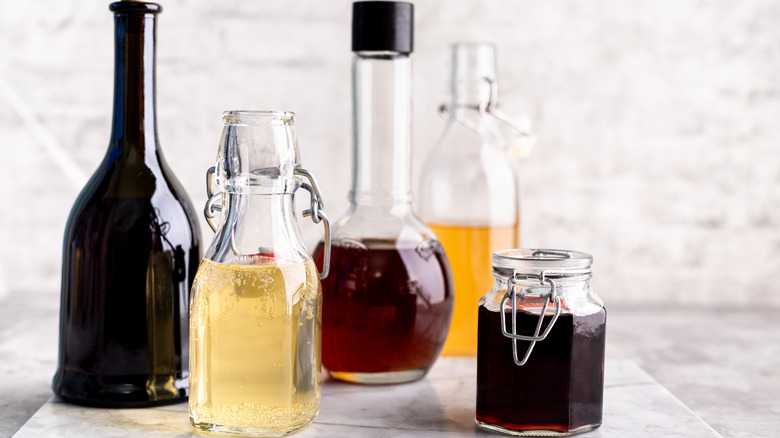The Type Of Vinegar José Andrés Uses For Super Flavorful Gazpacho
A Spanish summer staple, gazpacho is a refreshing soup that's served cold. Almost like a salad that swaps forks for spoons, Love and Lemons shares that the dish is made with a variety of fresh vegetables, blended with olive oil, and other zesty ingredients. Especially vibrant thanks to a pop of acidity, world-renowned Spanish chef José Andrés reveals there's one vinegar that'll take any gazpacho to flavorful new heights.
A Michelin-starred chef, restaurateur, and humanitarian, NPR explains that Andrés is often credited with introducing the concept of tapas, or small sharing plates, to the American public. Of the many creations Andrés has proposed to the U.S., gazpacho is one that holds very dear to the chef, whose wife Patricia (while not a fan of cooking) is stellar at making gazpacho. Perhaps drawing roots from her Andalusian roots, the chef told Today that Tichi's gazpacho is one of the things that convinced him to marry her.
Uncomplicated, yet luxurious, Andrés shares that his wife's gazpacho is made by blending ingredients, straining, and then chilling before garnishing with a drizzle of oil and flaked sea salt and serving. As for what exactly goes into the cold soup, the chef lists peppers, cucumbers, tomatoes, garlic, olive oil, oloroso sherry, and most importantly, sherry vinegar.
Sherry vinegar adds pizzazz
"For the best flavor for the gazpacho, be sure to use a good Spanish sherry vinegar," Chef Andrés told Today. "And you'll see that the oloroso sherry adds extra depth to the flavor."
A culinary must-have, sherry vinegar hails from the same region responsible for producing sherry wine in Jerez de la Frontera. Made with the same grapes (palomino, Pedro Ximinez, and moscatel, per Kitchn) used to make sherry, the gourmet vinegar is aged in wooden casks following the solera system where younger batches of vinegar are blended with older batches. As the grapes ferment, Culinary Collective explains that bacteria turns the substance into sherry before alcohol and oxygen are transformed into acetic acid and water to form vinegar. Following strict regulations, sherry wine vinegar that's protected by the Denominación de Origen must be aged for at least six months to be labeled vinagre de Jerez, two years to be labeled Reserva, and over 10 years for Gran Reserva designation, reports Serious Eats.
Given that the wine vinegar is produced in much of the same way as sherry wine, it boasts similar tasting notes. According to Despaña, much like an oloroso sherry wine, its acidic companion is equally as texturally rich, expressing similar nuances of nuts and spices. That said, adding a splash of sherry vinegar, especially of the same style, highlights the flavors of the oxidized oloroso sherry, while delivering a punchy burst of much-needed acidity.

